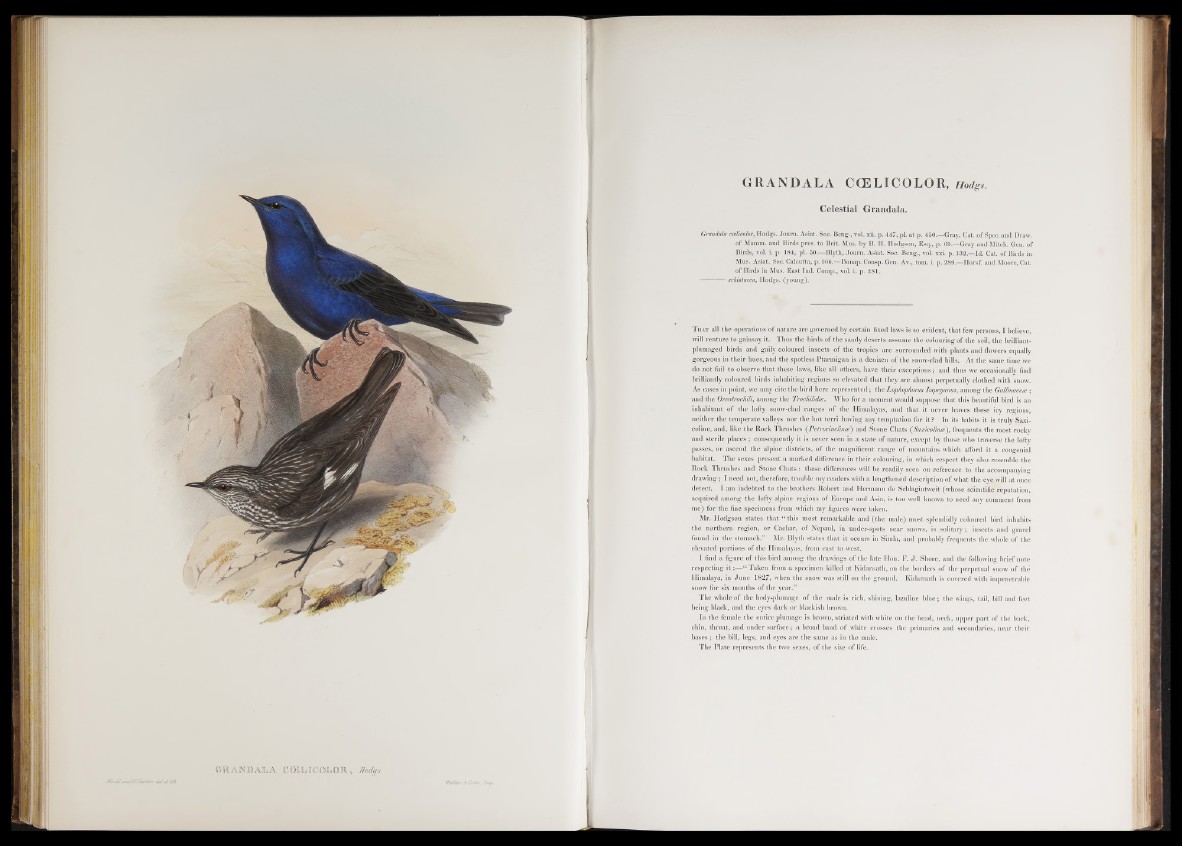
J.Couldccnd/Í.Cñtchler del el lilk.
GUARDALA CQLL.ICOLOR, Modtjs.
W alter & Cohn, Imp.
GRANDALA CGELICOLOR, Hodgs.
Celestial Grandala.
Grandala ccelicolor, Hodgs. Joum. Asiat. Soc. Beng., vol. xii. p. 447, pi. at p. 450.—Gray, Cat. of Spec, and Draw.
of Mamm. and Birds pres, to Brit. Mus. by B. H. Hodgson, Esq., p. 69.—Gray and Mitch. Gen. of
Birds, vol. i. p. 184, pi. 50.—Blyth, Journ. Asiat. Soc. Beng., vol. xxi. p. 132.—Id. Cat. of Birds in
Mus. Asiat. Soc. Calcutta, p. 166.—Bonap. Consp. Gen. Av., tom. i. p. 289.—Horsf. and Moore, Cat.
of Birds in Mus. East Ind. Comp., vol. i. p. 281.
------------schistacea, Hodgs. (young).
T hat all the operations of nature áre governed by certain fixed laws is so evident, that few persons, I believe,
will venture to gainsay it. Thus the birds o f the sandy deserts assume the colouring of the soil, the brilliant-
plumaged birds and gaily coloured insects of the tropics are surrounded with plants and flowers equally
gorgeous in their hues, and the spotless Ptarmigan is a denizen of the snow-clad hills. At the same time we
do not fail to observe that these laws, like all others, have their exceptions; and thus we occasionally find
brilliantly coloured birds inhabiting regions so elevated that they are almost perpetually clothed with snow.
As cases in point, we may cite the bird here represented; the Lophophorus Impeyatius, among the Gallinacece;
and the Oreotrochili, among the Trochilidce. Who for a moment would suppose that this beautiful bird is an
inhabitant of the lofty snow-clad ranges of the Himalayas, and that it never leaves these icy regions,
neither the temperate valleys nor the hot terri having any temptation for it ? In its habits it is truly Saxi-
coline, and, like the Rock Thrushes ('Pelrocinclince) and Stone Chats {Saxicolince), frequents the most rocky
and sterile places ; consequently it is never seen in a State of nature, except by those who traverse the lofty
passes, or ascend the alpine districts, of the magnificent range of mountains which afford it a congenial
habitat. The sexes present a marked difference in their colouring, in which respect they also resemble the
Rock Thrushes and Stone Chats : these differences will be readily seen on reference to the accompanying
drawing; I need not, therefore, trouble my readers with a lengthened description o f what the eye will a t once
detect. I am indebted to the brothers Robert and Hermann de Schlagintweit (whose scientific reputation,
acquired among the lofty alpine regions of Europe and Asia, is too well known to need any comment from
me) for the fine specimens from which my figures were taken.
Mr. Hodgson states that “ this most remarkable and (the male) most splendidly coloured bird inhabits
the northern region, or Cachar, of Nepaul, in under-spots near snows, is solitary; insects and gravel
found in the stomach.” Mr. Blyth states that it occurs in Simla, and probably frequents the whole of the
elevated portions of the Himalayas, from east to west.
I find a figure of this bird among the drawings of the late Hon. F. J . Shore, and the following brief note
respecting i t :— “ Taken from a specimen killed at Kidarnath, on the borders of the perpetual snow of the
Himalaya, in June 1827, when the snow was still on the ground. Kidarnath is covered with impenetrable
snow for six months of the year.”
The whole o f the body-plumage o f the male is rich, shining, lazuline blue; the wings, tail, bill and feet
being black, and the eyes dark or blackish brown.
In the female the entire plumage is brown, striated with white on the head, neck, upper part of the back,
chin, throat, and under surface; a broad band of white crosses the primaries and secondaries, near their
bases ; the bill, legs, and eyes are the same as in the male.
The Plate represents the two sexes, of the size of life.